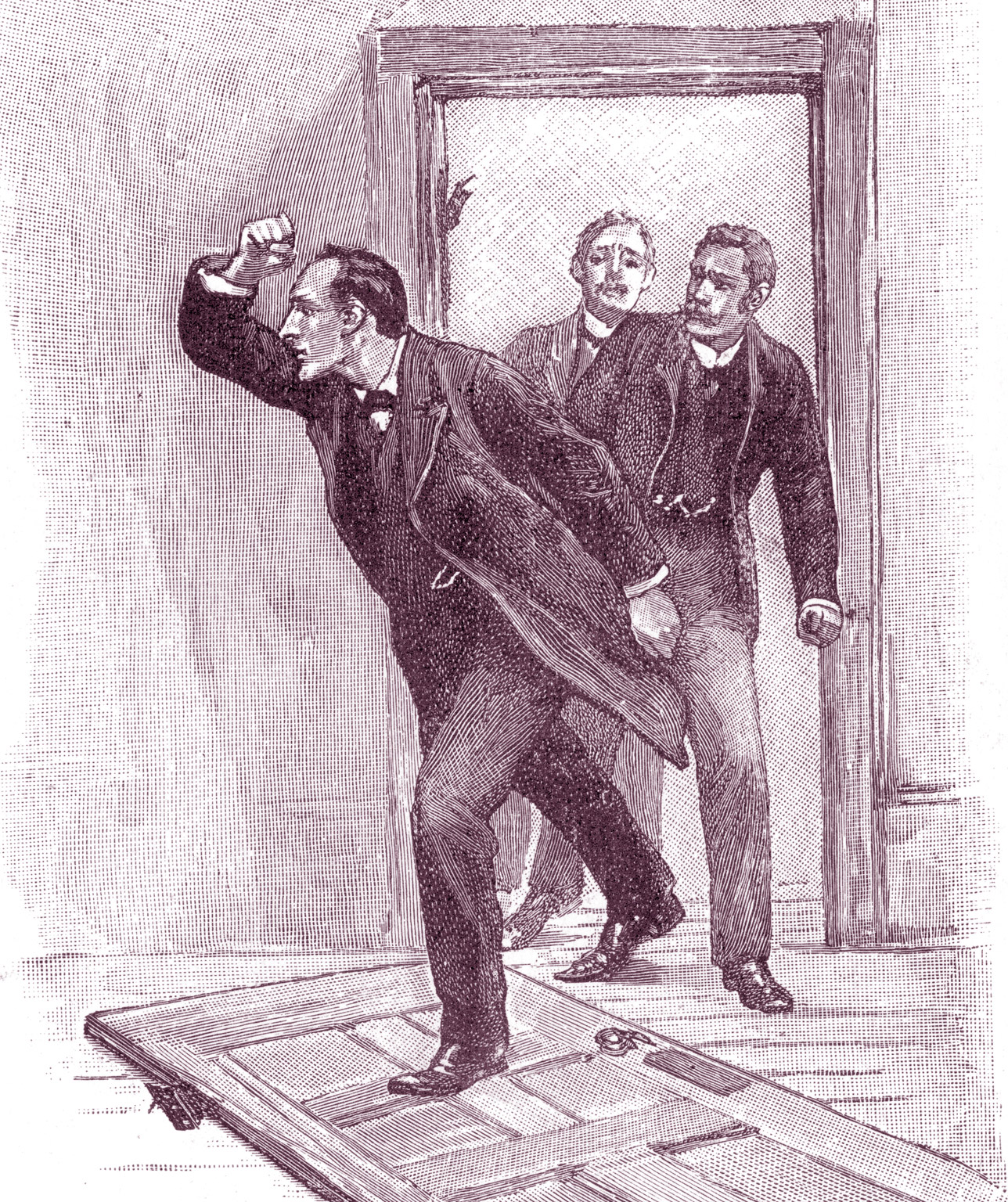
IN CONTEXT
Short story
UK: March 1893
US: March 1893
The Memoirs of Sherlock Holmes, 1894
Hall Pycroft Young stockbroker’s clerk.
Arthur Pinner Financial agent based in London.
Harry Pinner Owner of a newly established hardware distribution company, based in Birmingham.
Beddington Criminal who has just been released from a five-year prison sentence.
When Conan Doyle wrote “The Stockbroker’s Clerk” his earnings from the Sherlock Holmes stories were reaching a level at which he had money of his own to invest. He began to deal with the brokerage of Pim, Vaughan and bought shares in ventures such as the Portsmouth Tram Company and Australian mines. Doubtless, therefore, he was well aware that fraud was rife in the financial world at the time. In this story, he displays a knowledge of how businesses worked, using a plot that turns, plausibly, on the pitfalls inherent in the way London firms like the fictional Mawson & Williams hired their staff.

A dream job turns sour
The stockbroker’s clerk in the title is young Hall Pycroft, and he is traveling to Birmingham by train with Holmes, whose services he has engaged, and Watson. During the journey, he tells them about the case. He was let go from his clerk’s job a while ago, and after a long and desperate search for a new job he finally landed a post at major London stockbrokers Mawson & Williams. However, shortly before Pycroft was due to take up the position, he was offered a better-paying job by a man named Arthur Pinner, who instructed him to travel to Birmingham to meet his brother Harry, the “promoter” of the Franco-Midland Hardware Company, at their offices. Flattered by the offer, Pycroft accepted the job, signing a declaration stating his willingness to join the company, and agreeing to not officially resign his post at Mawson & Williams.
In Birmingham, Harry took Pycroft to the company’s office, which turned out to be a couple of small, dusty, and sparsely furnished rooms. Pycroft began to work, but soon felt a vague sense of unease. He then observed that Harry had a gold filling on the same tooth as his brother, and suspected that they must be the same man. His suspicions aroused, Pycroft consulted Holmes, who agreed to probe his mysterious new employer.
When the trio arrive at Pycroft’s Birmingham office, with Holmes and Watson posing as job-seekers, they find Pinner reading a newspaper and looking highly distraught; he asks them to leave him alone for a moment. Hearing strange sounds, they burst back into the room and find him hanging from a hook on the door. After cutting him down and reviving him, Holmes deduces that Pinner has devised a fictitious post for Pycroft in Birmingham, to get him out of the way so a crime could be committed at Mawson & Williams in London.

In a dramatic scene, illustrated here in The Strand Magazine, Holmes, Watson, and Pycroft force their way into Pinner’s office and find him attempting to commit suicide.
A murderous thief
The newspaper Pinner was reading reveals both the details of the crime and the reason for Pinner’s despair. His real brother, a notorious forger and safe-breaker called Beddington, had taken up Pycroft’s position at Mawson & Williams; it was easy to impersonate the young clerk, since no one in the company had actually met him. Then, the previous Saturday, Beddington had dallied in the office, murdered the guard, and tried to make off with a bag stuffed with almost £100,000 in bonds. But an astute policeman, surprised to see a man leaving the office so late with a bag, arrested him, and the crime was discovered. All that remains, the paper reports, is to catch Beddington’s brother, who usually works with him. “We may save the police some little trouble in that direction,” remarks Holmes.
Holmes seems surprisingly sympathetic toward Pinner, who, having been driven to suicide on hearing of his brother’s arrest, is now facing prison for his role in the crime. In fact, Holmes often stands outside the law, and is happy to see natural justice done instead. It is, of course, what puts him in Scotland Yard’s bad books, but it also saves him the trouble of having to build a legal case—once he has explained it, the reader is satisfied that justice has run its course. However, Holmes knows that in this case they must hand Pinner over to the police. The tale is also unusual in that, when he arrives at the solution, Holmes is far from the crime scene, and is only able to apprehend the accomplice. The felony itself took place within London, and it was only the sharp eyes of a policeman that led to the arrest of the perpetrator.
FINANCIAL FELONS
The financial world of the late 19th century was highly corrupt. At least one in six company launches on the stock market was fraudulent, with swindlers taking investors’ money and then vanishing. Banking was just as corrupt as the stock market, with 242 out of the 291 private banks formed between 1844 and 1868 failing, often because of fraud. When the giant City of Glasgow Bank failed in 1878, it transpired that the directors had lent millions to friends and family with no collateral, and cooked the books to cover it up. However, the police almost never investigated what is known today as “white-collar crime,” concentrating instead on the working-class felon. Such was the level of theft and corruption in the business world that Beddington, posing as a clerk, would hardly have needed to murder the security guard and carry the bonds off in a bag. Huge sums of money were hemorrhaging each day through the slippery hands of “legitimate” employees.
